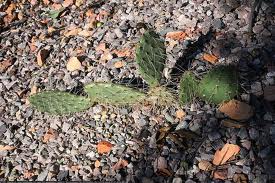Opuntia
Pot Cultivation
These plants require a minimum temperature of 50� F. When growing these plants indoors, they should have a soil mixture of two parts of sandy loam, one part of broken brick and one part of sand. Repotting doesn't need to be done every year; in fact, they can remain in the same pots for several years. Only if the soil is worn out or the plants stop growing well does it become necessary to repot in March or April. Remove the crocks and loose soil from the roots and plant them in slightly larger pots if their roots are healthy and abundant; if they have a small root system, then pot them in pots just large enough to hold them without crowding. The soil shouldn't be watered until it becomes dry, then soak it and wait for it to dry again before watering. Repeat this until the pots fill up with roots and then just keep the soil moist throughout the summer. During the winter, the soil is only soaked once in a while, just enough to keep the stems from shriveling. Plants growing in a home rather than a cool greenhouse may need a little more water since the temperature is a little warmer. Shading isn't required but good ventilation at all times is. In the summer, Opuntias growing in pots can be set outside. In mild, semi-desert or desert regions, Opuntias grow wild easily and unless they're controlled, can become serious pests. Some of these plants spread quickly, a tiny piece of stem that comes into contact with soil will take root and their seeds, which are spread by birds, germinate rapidly. In some countries where they have been introduced, such as Australia, they have covered large areas and become a pain to farmers who find it difficult to get rid of them. In the northern United States, O. compressa may be grown outside in well-drained soil especially when it's sandy soil near the sea. Other hardy varieties can be grown in a well-prepared bed that has excellent drainage against a south-facing wall. It's good to have the bed raised a few inches above the surrounding ground. In the winter, it would be beneficial to protect them by covering them with glass, cold-frame sash, or some similar device. The fruits of the Prickly Pears usually turn dark red when they are ready to be harvested. They are sweet and juicy when ready. If there is threat of frost, pick fruits a bit early and ripen indoors. Pads can be singed, then sliced and steamed at any stage of growth. Wear gloves to handle the pads or prickly pears and use tongs while singeing or brushing to remove the prickles. Although small and innocent looking, glochids (prickly bristles) can penetrate the skin and cause considerable pain.Propagation
Pieces of the stem of any size can be detached and laid aside for a few hours to allow a protective "skin" to form over the cut. They can then be planted in pots of sand or very sandy soil. Place them in a spot where they'll receive full sun and do not water until the soil becomes pretty dry. After a while the soil can be moistened regularly but never kept constantly saturated. In mild climates, cuttings will root if planted directly in soil outside. Seeds can be sown in the spring or summer in well-drained pots of sandy soil that are half-filled with crocks that are covered with rough siftings from the compost. Make sure the surface is smooth and even and sow the seeds thinly on top. Cover them with a bit of fine soil. Moisten and lay a piece of glass across the top. The pots should be set in a warm greenhouse or sunny window until they start to sprout after which the glass should be removed so they can receive full light and air. It isn't good to keep the glass over the seedlings, so if some of them are up before others, they may be pricked out and placed in another pot. The transplanted seedlings should not be disturbed until they are well rooted after which they can be planted separately in small pots. |
O. polyacantha |
VARIETIES
- O. compressa;
- O. arenaria;
- O. fragilis;
- O. imbricata;
- O. phaeacantha;
- O. polyacantha;
- O. fulgida & var. fulgida;
- O. invicta;
- O. lindheimeri;
- O. microdasys & var. alba, monstrosus;
- O. tunicata;
- O. vestita;
- O. aurantiaca;
- O. basilaris;
- O. cylindrica;
- O. dillenii;
- O. ficus-indica;
- O. leucotricha;
- O. pentlandii (boliviana);
- O. pottsii (filipendula);
- O. spinosissima;
- O. whipplei;
- O. neoargentina (Tree Opuntia);
- O. paraguayensis (Riverina Pear).




